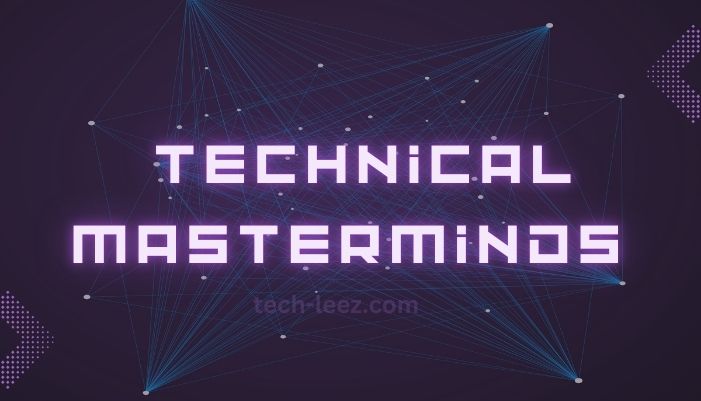In our tech-driven world, technical masterminds build our digital future. These smart folks mix deep tech know-how with fresh ideas to fix big problems. From Silicon Valley leaders to coding wizards behind the scenes, they push what’s possible with tech.
This article looks at what makes technical masterminds special. We’ll meet some of the most important ones in recent times. We’ll also see how their way of solving problems can help us think better. If you want to be a tech leader or just wonder about the people behind today’s amazing tech, this article is for you.
The Making of a Technical Mastermind: Key Traits and Skills
What makes technical masterminds different from regular tech workers? It’s not just about being smart or having tech skills—though these matter. The most important technical masterminds share some key traits that help them see what others miss.
Deep Technical Know-How
At their core, technical masterminds know their field inside and out. This deep knowledge is the base for all their new ideas. Whether it’s computer science, electrical engineering, or AI, they know the basics well and keep learning new things.
Look at Linus Torvalds, who made Linux and Git. He knew so much about how operating systems work that he could build an open-source system now used in Android phones and big computers. This kind of knowledge takes years of hard work and study.
Forward-Thinking
Technical masterminds don’t just fix problems—they see how tech might change and affect society. This lets them work on fixing problems most people don’t even see yet.
Elon Musk shows this trait in his work with Tesla, SpaceX, and Neuralink. While others thought electric cars weren’t practical and space travel was just for governments, Musk saw a future where both would change through private work. His ability to see past today’s limits has sped up progress in many fields.
Knowledge Across Many Fields
The most amazing technical masterminds often get ideas from many fields. This mixing of ideas helps them make links that experts in just one field might miss.
Steve Jobs used ideas from writing art and design when making computers. He made products that weren’t just good tech but also nice to look at and easy to use. This mix of art and tech became Apple’s style and changed how we use digital devices.
Historical Technical Masterminds Who Changed The World
Through history, some technical masterminds made such big changes that they changed the path of tech growth. Looking at what they did helps us understand today’s new ideas.
Ada Lovelace: The First Computer Coder
In the 1840s, long before we had computers, math expert Ada Lovelace wrote what we now know as the first set of steps for a machine to follow. Working with Charles Babbage on his Analytical Engine, Lovelace saw the future of computing machines going beyond just math to work with symbols.
Her notes have ideas that wouldn’t be used for another hundred years. This makes her the world’s first computer coder and a technical mastermind far ahead of her time.
Nikola Tesla: Electrical Pioneer
Nikola Tesla’s work in electrical engineering—like AC power systems, wireless energy sending, and early radio tech—changed the world. What made Tesla a true technical mastermind was his ability to see full systems in his mind before building them.
Tesla said he could test his ideas in his mind, finding problems and making them better without building real models. This amazing mental skill, plus his tech smarts, let him think of tech that was decades ahead of his time.
Grace Hopper: Computing Pioneer
Rear Admiral Grace Hopper made the first compiler, which turned human-readable code into machine code. This made computing open to many more people and laid the groundwork for modern coding languages.
Hopper’s status as a technical mastermind comes not just from her coding work but from seeing that computers needed to be user-friendly to reach their full use. Her vision of making machines work for people, not forcing people to adapt to machines, still shapes how we make software today.
Modern Technical Masterminds Reshaping Technology
Today’s technical masterminds build on what came before while taking on new challenges. They follow both timeless rules of new thinking and new ways for our fast-changing tech world.
Jensen Huang: The AI Hardware Pioneer
As founder and CEO of NVIDIA, Jensen Huang changed a gaming graphics company into the top provider of hardware for AI. Huang’s skills as a technical mastermind show in how he saw that GPU tech could be used for machine learning long before AI became big.
Under his lead, NVIDIA made special chips that sped up AI training, enabling breakthroughs in self-driving cars and medical imaging. Huang’s tech vision helped solve one of the main blocks in AI growth: computing power.
Katherine Johnson: Math Genius Behind Space Travel
Katherine Johnson’s math was key to NASA’s early space missions, including John Glenn’s orbit around Earth and the Apollo Moon landing. Working as a “human computer” before electronic computers were reliable, Johnson made complex math steps for plotting space paths.
What makes Johnson a technical mastermind isn’t just her math skills but her ability to solve brand new problems where failure meant loss of human life. Her work shows how technical masterminds often do well under pressure, finding neat answers to seemingly impossible challenges.
Tim Berners-Lee: Creator of the World Wide Web
Tim Berners-Lee invented the World Wide Web while working at CERN, changing how we share and access info worldwide. What sets Berners-Lee apart as a technical mastermind is not just making the web but deciding to make it free without patents or fees.
This choice allowed fast growth and new ideas, changing the web from a science tool into a global talking platform. Berners-Lee still fights for an open, free internet, showing how technical masterminds often think about the wider social impact of their work.
How Technical Masterminds Solve Problems
Beyond their specific work, technical masterminds offer good lessons in how to tackle complex problems. Their methods often share common parts that can be used across many tech fields.
First-Principles Thinking
Many technical masterminds use first-principles thinking—breaking down hard problems into their most basic parts and building them back up from scratch. This lets them question things others take for granted and find new answers.
When Elon Musk wanted to cut the cost of space launches, he didn’t accept the common view that rockets were just costly. Instead, he broke down the problem to its basics: what are rockets made of, and what do they really cost? This led SpaceX to build reusable rockets, greatly lowering the cost of space travel.
Quick Testing and Improving
Technical masterminds rarely get things right the first time. Instead, they make working models quickly, test them well, and make them better step by step. This way of working allows for faster learning and cuts the risk of following dead-end paths.
Thomas Edison famously tried thousands of times before making a good light bulb. Rather than seeing these as failures, he saw each failed try as useful data that brought him closer to an answer—a mindset that marks many technical masterminds.
Working With Others
While we often think of technical masterminds as lone geniuses, many work in teams, using diverse views to solve complex problems. Their genius is partly in their ability to gather and inspire skilled helpers.
Katherine Johnson worked as part of NASA’s team of “human computers,” mostly Black women whose math skills were key to the space program’s success. Today’s AI breakthroughs at places like DeepMind come from teams of researchers mixing different skills to tackle problems no one person could solve alone.
How to Think Like a Technical Mastermind
Not everyone will be the next Ada Lovelace or Steve Jobs, but we can all use parts of technical mastermind thinking in how we solve problems and create new things.
Develop T-Shaped Knowledge
Technical masterminds often have “T-shaped knowledge”—deep know-how in one area (the down part of the T) mixed with wider knowledge across many fields (the across part of the T). This mix lets them use special skills while making links across fields.
To build this kind of knowledge, focus on getting deep in your main tech field while also learning about related areas. If you’re a coder, for instance, learning about design or user psychology can help you make better software.
Welcome Learning From Failures
Technical masterminds don’t fear failure—they learn from it. Each failed try gives useful data for future efforts. This shift from avoiding failure to seeing it as part of learning is key for new thinking.
When James Dyson was making his ground-breaking vacuum cleaner, he made 5,126 prototypes before finding a good design. Rather than getting upset, he saw each try as progress toward his goal—an approach that sets technical masterminds apart from those who give up at the first sign of trouble.
Be Hopeful But Real
The most important technical masterminds mix real views of challenges with strong belief in their ability to overcome them. This smart hope keeps them going through setbacks while making sure they don’t ignore real roadblocks.
When facing complex problems, practice balancing critical thinking with helpful hope. See problems clearly, but focus on finding possible answers rather than dwelling on why something can’t be done.
The Future of Technical Masterminds
As tech keeps changing faster and faster, the role of technical masterminds is changing too. Several trends are shaping how future innovators will tackle complex tech challenges.
More Access to Tools and Knowledge
Access to powerful tech tools and knowledge has never been more widespread. Open-source software, online learning sites, and cheap computing hardware are letting people from all backgrounds get tech skills that were once limited to top schools.
This means tomorrow’s technical masterminds may come from unexpected places. The next big step in AI or clean energy could come from someone who learned coding through free online resources or built their first robot with low-cost parts.
Working Together Across Distances
While solo technical masterminds will keep making important work, we’re seeing more breakthrough ideas come from spread-out teams working together across places and groups. Open-source projects like Linux and joint research in fields like gene study show how group smarts can tackle problems too complex for any one person.
Future technical masterminds may stand out not just through personal brilliance but through their ability to lead and boost the work of global networks of helpers.
Mixing Fields to Fix Complex Problems
Many of mankind’s biggest challenges—from climate change to fighting pandemics—need answers that span multiple tech fields. Tomorrow’s technical masterminds will likely work where fields meet, mixing know-how in areas like computer science, biology, materials science, and social systems.
This trend toward mixing fields means that wide knowledge may become as important as deep knowledge for future tech innovators.
Conclusion
Technical masterminds have always been key drivers of human progress, from the industrial revolution to today’s digital change. Their mix of deep know-how, forward vision, and staying power lets them see chances others miss and turn big ideas into real-world answers.
While we celebrate the work of known technical masterminds like Ada Lovelace, Grace Hopper, and Tim Berners-Lee, it’s important to remember that new thinking can come from anyone willing to build the needed skills and mindset. By studying how technical masterminds tackle problems and using their methods in our own work, we can all help solve the complex challenges facing our world.
As tech keeps changing, the need for technical masterminds will only grow. Whether they’re working on AI, clean energy, space travel, or fields we haven’t yet imagined, these bright innovators will keep shaping our shared future. By understanding what drives them and how they think, we gain useful insights into both the tech of tomorrow and our own ability for creative problem-solving.
FAQs About Technical Masterminds
What schooling do most technical masterminds have?
While many technical masterminds have formal schooling in their fields, there’s no single path that makes great thinkers. Some, like Steve Jobs and Bill Gates, left college early. Others, like Grace Hopper and Katherine Johnson, had high-level degrees. What matters more than degrees is a drive to keep learning and using knowledge in new ways to solve problems.
Are technical masterminds born or made?
Research shows it’s a mix of both. While some brain skills may be partly genetic, the traits that define technical masterminds—deep know-how, creative problem-solving, staying power—can all be grown through hard work and real-world use. The most successful pioneers usually mix natural gifts with years of focused effort to build their skills.
How do technical masterminds keep up with fast-changing tech?
Most technical masterminds have clear ways to keep learning. This often means setting aside time for reading research, trying new tech, taking part in sharing groups, and staying in touch with other experts. Many also practice teaching ideas to others, which makes their own understanding stronger.
Can someone become a technical mastermind later in life?
Yes! While some technical masterminds show promise early, others grow their skills later in their careers. Ray Kroc was 52 when he changed the fast-food world with McDonald’s, using systems thinking for running restaurants. The key is keeping your wonder and will to challenge old ways, no matter your age.
How do technical masterminds handle failure?
Rather than being stopped by failure, technical masterminds see it as helpful feedback. They study what went wrong, pull out lessons for future work, and keep going with better plans. This bounce-back after setbacks is one of the most common traits across successful innovators throughout history.
What’s the difference between a technical mastermind and a successful business person?
While there’s often overlap, technical masterminds stand out mainly by their tech skills and new ideas, while business people focus on building lasting companies. Some people, like Elon Musk, do well in both areas, but many technical masterminds team up with business-minded partners or work in big groups rather than starting companies on their own.


